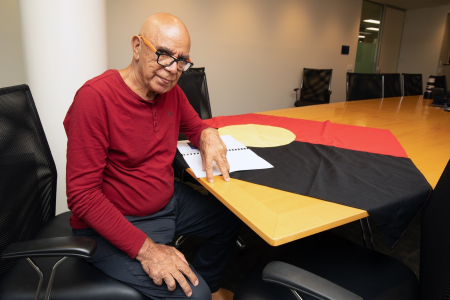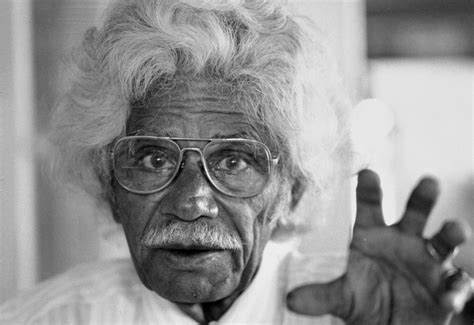Respected Luritja artist and activist Harold Thomas was recently presented with an honorary doctorate from Charles Darwin University's Casuarina Campus
Red, Black, and Yellow – the iconic colours of the Aboriginal flag stand as a symbol of unity and national identity for many Aboriginal people.
Now, 52 years after it was first raised at Tarntanyangga, Victoria Square, in Adelaide – the designer of the flag, Harold Thomas, has received an Honorary Doctorate from Charles Darwin University.
“The creation of Art is my life and will continue to be,” Mr Thomas said.
Painting watercolours and landscapes from the age of 14, Mr Thomas’ trajectory as an artist started when he won a scholarship to the South Australian School of Art for a study of Modern and Contemporary Fine Art, later becoming the first Aboriginal person to graduate from an Australian art school.
Amidst his studies and work as a survey artist at the South Australian Museum, Mr Thomas also became actively involved in social justice for Aboriginal rights.
In 1972, the Aboriginal flag was adopted by the Aboriginal Tent Embassy outside the old Parliament House in Canberra.
“The Flag represents the timeless history of our land and our people’s time on it,” Mr Thomas said.
Professor Reuben Bolt is the university’s Vice-Chancellor of First Nations Leadership, and he’s told NIRS News, the Luritja artist was nominated for his contribution to fine arts and activism for the rights of Aboriginal and Torres Strait Islander people.
“His artistic endeavours are long standing and have been developed over many years, across many artistic disciplines,” Professor Bolt said.
“One of his most influential works, was the design of the Aboriginal flag which later became one of the most recognisable symbols of Aboriginality – a national symbol that featured prominently in the social justice and land rights movements in Australia.
“It was a symbol of activism, yet at the same time, it was and still is, a symbol of unity and solidarity amongst Aboriginal peoples in Australia.”





